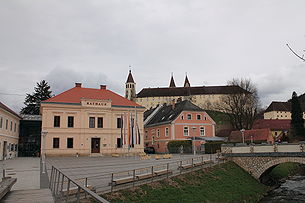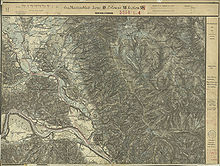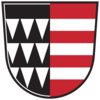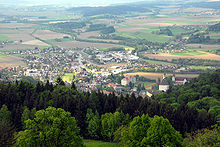Sankt Paul im Lavanttal
|
market community St. Paul in the Lavant Valley
|
||
|---|---|---|
| coat of arms | Austria map | |
|
|
||
| Basic data | ||
| Country: | Austria | |
| State : | Carinthia | |
| Political District : | Wolfsberg | |
| License plate : | WHERE | |
| Surface: | 47.46 km² | |
| Coordinates : | 46 ° 42 ' N , 14 ° 52' E | |
| Height : | 412 m above sea level A. | |
| Residents : | 3,273 (January 1, 2020) | |
| Population density : | 69 inhabitants per km² | |
| Postal code : | 9470 | |
| Area code : | 0 43 57 | |
| Community code : | 2 09 18 | |
| NUTS region | AT213 | |
| UN / LOCODE | AT SLV | |
| Address of the municipal administration: |
Place St. Blasien 1 9470 St. Paul in Lavanttal |
|
| Website: | ||
| politics | ||
| Mayor : | Stefan Salzmann ( SPÖ ) | |
|
Municipal Council : ( 2015 ) (23 members) |
||
| Location of St. Paul im Lavanttal in the Wolfsberg district | ||
 Town hall and pen |
||
| Source: Municipal data from Statistics Austria | ||
Sankt Paul im Lavanttal , officially St. Paul im Lavanttal , is a market town with 3273 inhabitants (as of January 1, 2020) in the Wolfsberg district in Carinthia .
geography
The St. Paul market is located in the Lavant Valley near the confluence of the Granitzbach and Lavant . A large part of the municipality is located in the Granitztal and on the foothills of the Saualpe .
Community structure


The community is divided into the eight cadastral communities Granitztal-St. Paul, Granitztal-Weissenegg, Johannesberg, Legerbuch, Kollnitz, Sankt Paul, Loschental and Weinberg. The municipality includes the following 21 localities (population in brackets as of January 1, 2020):
- German Slides (135)
- Goenitz (57)
- Granitztal-St. Paul (76)
- Granitztal-Weißenegg (411)
- Hundsdorf (99)
- Johannesberg (20)
- Kampach (83)
- Kollnitzgreuth (69)
- Legerbuch (152)
- Loschental (54)
- St. Margarethen (23)
- St. Martin (21)
- St. Paul im Lavanttal (1748)
- Schildberg (60)
- Stadling (83)
- House of Commons (5)
- Undergrowth (7)
- Vineyard (14)
- Windisch Slides (36)
- Winkling (34)
- Zellbach (86)
history
Two dedicatory inscriptions for the Celtic god Latobius were found from the Roman period (province of Noricum ) . The first written mention of the place as villula Brugga comes from a document from 1091: Count Engelbert von Spanheim donated a Benedictine monastery at an already existing Paulskirche instead of a Lavant castle . This village of Brugga on a bridge over the Granitzbach was a commercial and merchant settlement, which in 1184 in a document Pope Lucius III. was first referred to as market ( villam, quod forum dicitur ). In 1289 the place in the Klosterurbar was first expressly referred to as the St. Paul Market ( in foro sancti Pauli ); before (1255) Bernhard von Spanheim had granted the residents the corresponding rights. The market was always under the influence of the monastery, which is still an important economic factor today.
In 1874 the telegraph came to Sankt Paul. The opening of an imperial and royal state telegraph station with "limited daily services" took place at the same time as in other smaller places in the monarchy.
The market town, newly constituted in 1850, was renamed Spanheim in 1941, which was reversed in 1946. In 1957, the area around the so-called "Devil's Island" in the east and part of the dissolved local community of Legerbuch was enlarged. Further increases in the area followed through incorporations on the occasion of the municipal structural reform in 1973, which were partially reversed when St. Georgen became independent again in 1991.
Population development
According to the 2001 census, Sankt Paul has 3,680 inhabitants, 95.5% of whom are Austrian and 1.5% Bosnian citizens. 92.7% profess the Roman Catholic Church , 1.3% the Evangelical Church and 2.0% Islam . 2.7% of the population are without religious beliefs.
coat of arms
Today's coat of arms goes back to a market seal that was handed down for October 1, 1665 and was probably awarded under Abbot Philipp Rottenhäuser (ruled 1661–1677). It is composed of pieces of herald , which is rather untypical for this time.
The official blazon of the coat of arms reads: “Divided shield; in front three rows of silver wedges in black, behind in red three silver bars. ” This description of the coat of arms is heraldically incorrect in parts , in particular it is a split, not divided coat of arms . In 2006 the following proposal was therefore submitted: “Split shield; in front in black three rows of silver overturned gores under a reduced shield head, in the back divided six times by red and silver. "
The municipality was certified to be in charge of the coat of arms on October 22, 1973, and at the same time it was awarded a flag in red-white-black with an incorporated coat of arms.
Community partnerships
- St. Blasien , Germany
politics
The municipal council has 23 members.
- With the municipal council and mayoral elections in Carinthia in 2003, the municipal council had the following distribution: 14 SPÖ, 5 ÖVP, and 4 FPÖ.
- With the municipal council and mayoral elections in Carinthia in 2009 , the municipal council had the following distribution: 11 SPÖ, 8 BZÖ, and 4 ÖVP.
- With the municipal council and mayoral elections in Carinthia in 2015 , the municipal council has the following distribution: 11 SPÖ, 7 Zukunft St. Paul - Adi Streit, 3 FPÖ, and 2 ÖVP.
- mayor
- from 1991 to August 2020 Hermann Primus (SPÖ)
- since August 2020 Stefan Salzmann (SPÖ)
Culture and sights
- The Benedictine Abbey of St. Paul , founded in 1091, is a castle complex that served the Dukes of Carinthia as ancestral castle. Today the monastery is the oldest still active monastery in Carinthia and has one of the largest art collections in Europe as well as an extensive and important library. Inside the complex is a Romanesque basilica that was built at the end of the 12th century.
- The castle was also built as Ramestein Castle in 1091 to protect the monastery . It was destroyed in 1307, rebuilt, and was destroyed again by fire in 1636.
- The building for the Konvikt of the Stiftsgymnasium was built in 1889 in neo-Gothic style and expanded in 1909; At that time it was one of the largest with 200 places and with central heating and indoor swimming pool one of the most modern boarding schools of the Austro-Hungarian monarchy. The building of the Stiftsgymnasium was built in 1900 in the Ringstrasse style and, like the boarding school building, which was closed in 1976, houses the classes of the Stiftsgymnasium St. Paul.
- Ölbründl: Dietrich von Spanheim (1253–1303), from the house of the founder of the Benedictine monastery Sankt Paul, lived as a hermit in a cave in the forest north of the Johannesberg. This spring gushed from the mountain near his home. Many sick people made a pilgrimage to the hermit, who was said to be able to heal the sick. To do this, he scooped water from this spring with his hand, which immediately turned into oil. He rubbed the sick with it and healed them. When he died, he was buried on the hill under a chapel. Later the Johanneskirche was built on it.
- Stiftsmuseum
- Fruit growing museum
- Regular events
- St. Paul Cultural Summer
- St. Paul Oktoberfest
- St. Paul Church Day
- St. Pauler Fellner - Event
- Hugo Wolf Days
- St. Pauler Mostland Run
- Chopping board tournament of the TTC St. Paul
Personalities
- Gernot Kulis (* 1976), cabaret artist, Ö3 call boy
- Elisabeth Köstinger (* 1978 in Wolfsberg ), Federal Minister for Agriculture, Environment and Tourism.
- Gert-René Polli (* 1960), from 2002 to 2007 Director of the Federal Office for the Protection of the Constitution and Counter-Terrorism (BVT)
- Honorary citizen of the community
- Heinrich Ferenczy (1938–2018), abbot of the Benedictine monastery of St. Paul in the Lavant Valley
- Ignaz Lernbaß, teacher and mayor of the St. Paul parish 1979–1990
- Bruno Rader (* 1939), abbot of the Benedictine monastery of St. Paul in Lavanttal, initiator of the first Carinthian regional exhibition in 1991
- Albert Steiner, master builder
- Ring bearer of the municipality
- Gerfried Sitar (* 1968), Episcopal Vicar of the Diocese of Gurk, Director of the Stiftsmuseum St. Paul and Dean of St. Andrä, author and exhibition organizer
Web links
- Market town of St. Paul in Lavanttal
- 20918 - Sankt Paul im Lavanttal. Community data, Statistics Austria .
Individual evidence
- ↑ Statistics Austria: Population on January 1st, 2020 by locality (area status on January 1st, 2020) , ( CSV )
- ↑ Announcements. In: Klagenfurter Zeitung , December 10, 1874, p. 6 (online at ANNO ).
- ^ Statistics Austria, population census, demographic data. May 15, 2001, accessed March 3, 2019 .
- ^ Wilhelm Deuer: The Carinthian community arms . Verlag des Kärntner Landesarchiv, Klagenfurt 2006, ISBN 3-900531-64-1 , p. 252







